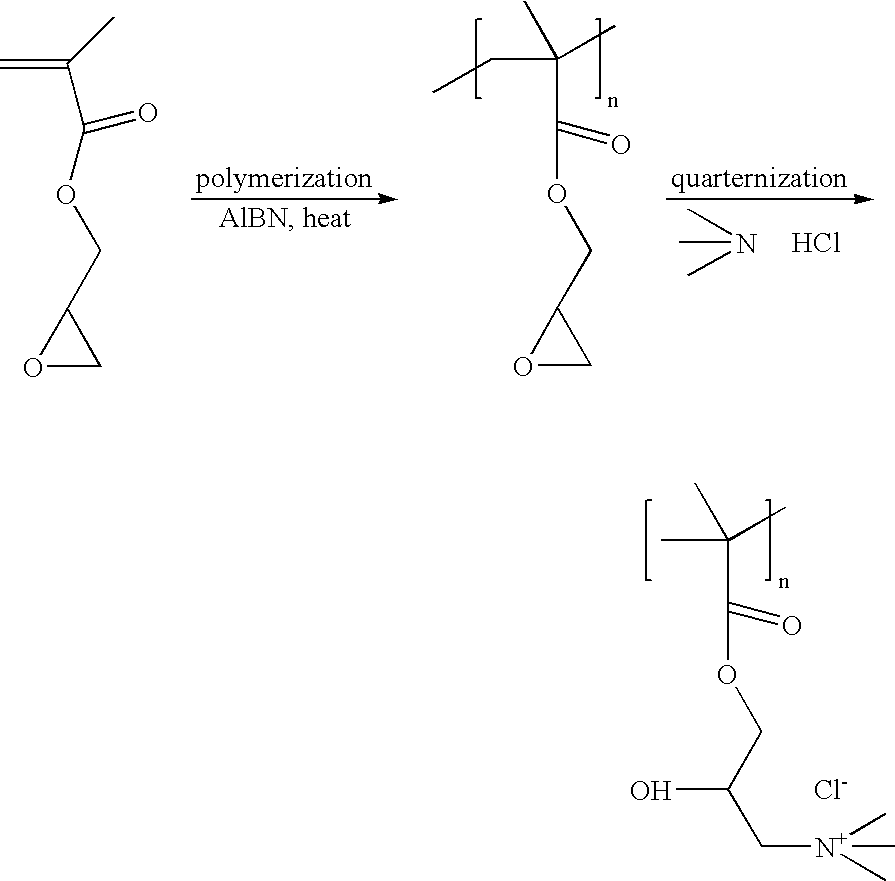Water treatment process
a technology of water treatment and water treatment solution, applied in water/sludge/sewage treatment, solid sorbent liquid separation, ion exchangers, etc., can solve the problem of not economically unfeasible pumping costs, reduce coagulant dose, reduce volume of floc produced, and alleviate taste and/or odor problems
- Summary
- Abstract
- Description
- Claims
- Application Information
AI Technical Summary
Benefits of technology
Problems solved by technology
Method used
Image
Examples
example resin 1
[0139] Magnetic polymer beads were prepared in accordance with the process of the copending application in the name of CSIRO and ICI using the following raw materials:
[0140] 1. Water: this is the continuous medium in which the organic phase is dispersed and then reacted.
[0141] 2. Gosenhol® GH 17: this is a high molecular weight polymeric surfactant, a polyvinyl alcohol, that disperses the organic phase in the water as droplets.
[0142] 3. Teric® N9: this is a low molecular weight surfactant that is added to further reduce the particle size of the dispersed organic phase.
[0143] 4. Cyclohexanol: this is the major porogen: it is a solvent for the monomers, but a non-solvent for the polymer, and it promotes the formation of voids and internal porosity in the resin beads.
[0144] 5. Dodecanol: this is the minor porogen.
[0145] 6. Solsperse® 24000: it is a solid phase dispersing agent and is a block copolymer of poly(hydroxystearic acid) and poly(ethyleneimine).
[0146] 7. Pferrox® 2228HC...
example resin 2
[0154] Magnetic polymer beads were prepared in accordance with the process of the copending application in the name of CSIRO and ICI using the following raw materials:
[0155] 1. Water: this is the continuous medium in which the organic phase is dispersed and then reacted.
[0156] 2. Gosenhol® GH 20: this is a high molecular weight polymeric surfactant, a polyvinyl alcohol, that disperses the organic phase in the water as droplets.
[0157] 3. Cyclohexanol: this is the major porogen: it is a solvent for the monomers, but a non-solvent for the polymer, and it promotes the formation of voids and internal porosity in the resin beads.
[0158] 4. Toluene: this is the minor porogen.
[0159] 5. Solsperse® 24000: it is a solid phase dispersing agent and is a block copolymer of poly(hydroxystearic acid) and poly(ethyleneimine).
[0160] 6. Pferrox® 2228HC γ-Fe2O3: gamma-iron oxide (maghemite). This is the magnetic oxide that makes the resin beads magnetic.
[0161] 7. KRATON® D1102: this is a low mole...
example 1
[0168] Raw water was obtained from the Myponga Reservoir, South Australia. The raw water was pumped into a stirred vessel and was dosed with resin manufactured according to Example Resin 1 at a rate of 2.6 ml of wet resin per liter of raw water. Resin and water were stirred in a flow through system for an average time of 10 minutes before settling for 10 minutes in a plate settler. The water passed up through the plate settler and the clarified water overflowed for collection. The temperature of the water during this process was in the range of from 14 to 16° C.
[0169] In the continuous process resin was recycled maintaining the 2.6 ml of wet resin per liter of raw water dose rate. 90% of the resin was recycled without regeneration. The remaining 10% was sent for regeneration (see Example 2).
[0170] The raw water and resin treated water were subjected to Standard Jar Tests.
[0171] Analyses including DOC, UV absorption and iron were also undertaken. The results of the jar tests on th...
PUM
| Property | Measurement | Unit |
|---|---|---|
| diameter | aaaaa | aaaaa |
| diameter | aaaaa | aaaaa |
| concentration | aaaaa | aaaaa |
Abstract
Description
Claims
Application Information
 Login to View More
Login to View More - R&D
- Intellectual Property
- Life Sciences
- Materials
- Tech Scout
- Unparalleled Data Quality
- Higher Quality Content
- 60% Fewer Hallucinations
Browse by: Latest US Patents, China's latest patents, Technical Efficacy Thesaurus, Application Domain, Technology Topic, Popular Technical Reports.
© 2025 PatSnap. All rights reserved.Legal|Privacy policy|Modern Slavery Act Transparency Statement|Sitemap|About US| Contact US: help@patsnap.com



